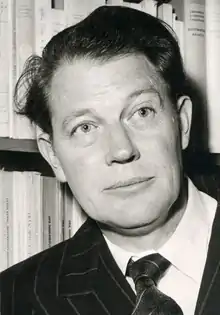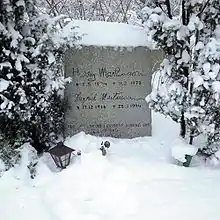Harry Martinson
Harry Martinson (6 May 1904 – 11 February 1978) was a Swedish author, poet and former sailor. In 1949 he was elected into the Swedish Academy. He was awarded a joint Nobel Prize in Literature in 1974 together with fellow Swede Eyvind Johnson "for writings that catch the dewdrop and reflect the cosmos".[1] The choice was controversial, as both Martinson and Johnson were members of the academy.[2]
Harry Martinson | |
|---|---|
 Harry Martinson | |
| Born | 6 May 1904 Jämshög, Sweden |
| Died | 11 February 1978 (aged 73) Stockholm, Sweden |
| Notable awards | Nobel Prize in Literature 1974 (shared with Eyvind Johnson) |
| Spouses | Moa Martinson (1929–1940) Ingrid Lindcrantz (1942–1978) |
He has been called "the great reformer of 20th-century Swedish poetry, the most original of the writers called 'proletarian'."[3]
Life
Martinson was born in Jämshög, Blekinge County in south-eastern Sweden.[4] At a young age he lost both his parents whereafter he was placed as a foster child (Kommunalbarn) in the Swedish countryside.[4] At the age of sixteen Martinson ran away and signed onto a ship to spend the next years sailing around the world visiting countries including Brazil and India.[4]

A few years later lung problems forced him to set ashore in Sweden[5] where he travelled around without a steady employment, at times living as a vagabond on country roads.[4] At the age of 21, he was arrested for vagrancy in Lundagård park, Lund.[6]
In 1929, he debuted as a poet. Together with Artur Lundkvist, Gustav Sandgren, Erik Asklund and Josef Kjellgren he authored the anthology Fem unga (Five Youths),[7] which introduced Swedish modernism. His poetry, characterized by linguistic innovation and a frequent use of metaphors, combined an acute eye for, and love of nature, with a deeply felt humanism.[8][9] His popular success as a novelist came with the semi-autobiographical Nässlorna blomma (Flowering Nettles) in 1935, about hardships encountered by a young boy in the countryside. It has since been translated into more than thirty languages. The novel Vägen till Klockrike (The Road to Klockrike, 1948) was another huge success, and in 1949 Martinson became the first proletarian writer to be elected a member of the Swedish Academy.[3]
One of his most noted works is the poetic cycle Aniara, which is a story of the spacecraft Aniara that during a journey through space loses its course and subsequently floats on without destination. The book was published in 1956 and became an opera in 1959 composed by Karl-Birger Blomdahl.[10][11] The cycle has been described as "an epic story of man's fragility and folly".[12]
From 1929 to 1940, he was married to Moa Martinson, whom he met through a Stockholm anarchist newspaper, Brand.[3] He travelled to the Soviet Union in 1934.[3][4] He and Moa were divorced due to her criticism of his lack of political commitment.[3] Moa became a writer; Harry married Ingrid Lindcrantz (1916–1994) in 1942.[3][4]
Controversy
The joint selection of Eyvind Johnson and Martinson for the Nobel Prize in 1974[3] was very controversial as both were members of the Swedish Academy and thus on the Nobel panel.[2] Graham Greene, Saul Bellow and Vladimir Nabokov were the favoured candidates that year.[13]
Death
The sensitive Martinson found it hard to cope with the criticism following his award, and committed suicide on 11 February 1978 at the Karolinska University Hospital in Stockholm by cutting his stomach open with a pair of scissors in what has been described as a "hara-kiri-like manner".[14][15]
Legacy
The 100th anniversary of Martinson's birth was celebrated around Sweden in 2004.[16]
Bibliography
Titles in English where known.
Novels
|
Essays
|
Poems
|
Radio plays
|
Stage play
|
Psalms
|
References
- "The Nobel Prize in Literature 1974". Nobel Foundation.
- Örjan Lindberger "Människan i tiden. Eyvind Johnsons liv och författarskap 1938–1976" Bonniers 1990, pp. 445–447
- "Harry Martinson" (in French). Retrieved 27 March 2012.
- Holm, Ingvar. "Harry Martinson". Svenskt biografiskt lexikon. National Archives of Sweden.
- Sjöberg, Leif (1974). "Harry Martinson: From Vagabond to Space Explorer". Books Abroad. Board of Regents of the University of Oklahoma. 48 (3 (Summer, 1974)): 476–485. doi:10.2307/40128696. JSTOR 40128696.
- Westerström, Jenny (6 January 2010). "Den hemlöse i svensk skönlitteratur efter 1900". Lund University. Retrieved 21 December 2015.
- Kumm, Björn (12 December 1991). "Obituary: Artur Lundkvist". The Independent. London. p. 13.
- "Harry Martinson – Biographical". Nobel Media AB. 2014. Retrieved 4 March 2015.
- "Harry Martinson". Albert Bonniers Förlag.
- Johansson, Stefan (31 May 2009). "50-åring ur kurs når ännu fram" [50 year old man of course still gets through]. www.svd.se. Svenska Dagbladet. Retrieved 14 February 2014.
- Liukkonen, Petri. "Harry Martinson". Books and Writers (kirjasto.sci.fi). Finland: Kuusankoski Public Library. Archived from the original on 9 April 2003.
- Critical survey of poetry. American poets. Reisman, Rosemary M. Canfield. (4th. ed.). Pasadena, Calif.: Salem Press. 2011. ISBN 9781587655937. OCLC 712652825.CS1 maint: others (link)
- Shankar, Ravi (12 October 2014). "A Prize With a View". www.newindianexpress.com. The New Indian Express. Retrieved 28 January 2016.
- Hansson, Anita (31 August 2000). "Martinson begick harakiri" [Martinson committed hara-kiri]. wwwc.aftonbladet.se. Aftonbladet. Retrieved 21 December 2015.
- Gyllensten, Lars (2000). Minnen, bara minnen [Memories, just memories] (in Swedish). Stockholm: Albert Bonniers Förlag. ISBN 91-0-057140-7. SELIBR 7150260.
- "Harry Martinson-sällskapets material" [Material from the Harry Martinson Society]. Uppsala University Library.
External links
| Wikimedia Commons has media related to Harry Martinson. |
- Petri Liukkonen. "Harry Martinson". Books and Writers
- A translator's look at Flowering Nettles Swedish book review
- Harry Martinson on Nobelprize.org

| Cultural offices | ||
|---|---|---|
| Preceded by Elin Wägner |
Swedish Academy Seat No.15 1949–78 |
Succeeded by Kerstin Ekman |
